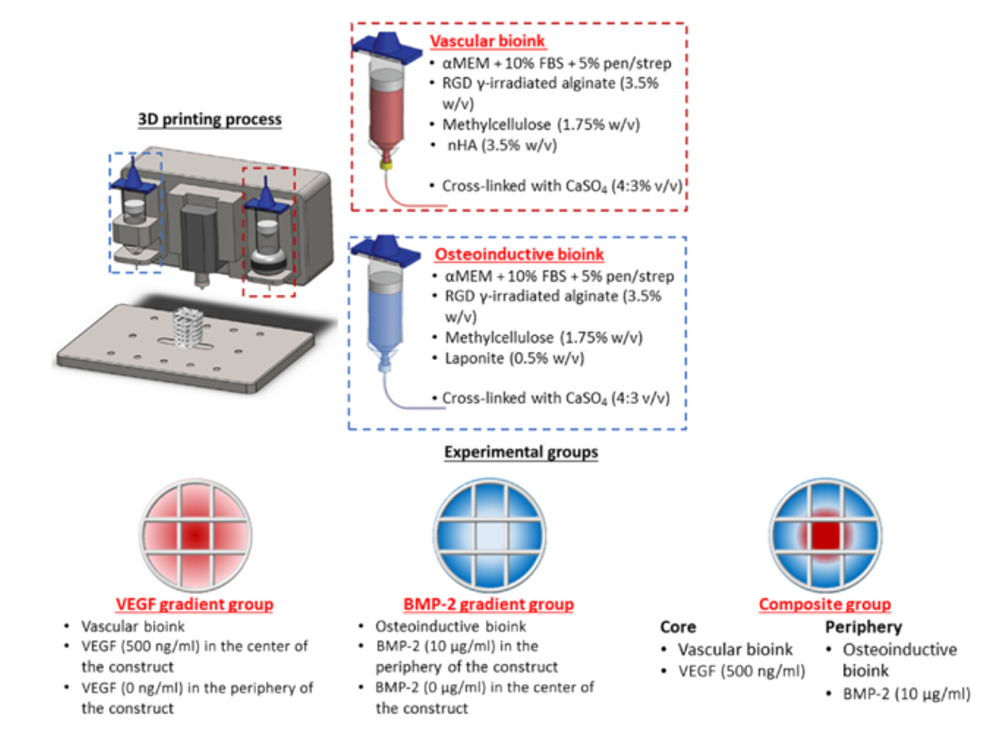
Sci. Adv. 2020 Aug; eabb509
近年来,许多生长因子在临床试验中被用于多种治疗应用,包括骨再生和缺血组织的新生血管化。尽管早期的结果很有希望,但在更大规模的二期试验中获得的结果往往没有显示出对患者的预期益处,有些还出现了明显的副作用。临床上,目前BMP-2的载体是胶原粉或海绵,它已被证明可以导致大量的初始爆裂释放,这与正常骨折修复期间观察到的表达谱形成对比,在正常骨折修复过程中,BMP的表达一直增加到第21天,这表明需要更缓慢和更持续的生长因子再释放谱。此外,由于生长因子的半衰期短和恶劣的骨折环境,超合理剂量的BMP-2被用来诱导骨再生,这与异位骨化等不良反应有关。因此,临床上显然有必要开发一种新的策略,将单一或多个生长因子以可持续的生理相关剂量输送到损伤部位,从而诱导修复,而不会产生这些不良反应。
近日,爱尔兰都柏林三一生物医学科学研究所的Fiona E. Freeman教授提出了一种新的时空可控传递生长因子的方法。开发了一系列纳米颗粒功能化的生物墨水,以精确控制3D打印植入物中生长因子的时间释放。而不需要超生理剂量。具体地说,适当的血管内皮细胞生长因子促进了体内的血管生成,当与明确的BMP-2定位和释放动力学相结合时,可以促进大段骨缺损的愈合,而异位骨形成较少。
In recent years, many growth factors have been used in clinical trials for a variety of therapeutic applications, including bone regeneration and neovascularization of ischemic tissue. Although the early results are promising, the results obtained in larger phase II trials often do not show the expected benefits to patients, and some have significant side effects. Clinically, the current carrier of BMP-2 is collagen powder or sponge, which has been shown to cause a large number of initial burst release, which is in contrast to the expression profile observed during normal fracture repair. During normal fracture repair, the expression of BMP increased to the 21st day, indicating the need for slower and more sustained growth factor re-release spectrum. In addition, due to the short half-life of growth factors and harsh fracture environment, ultra-reasonable doses of BMP-2 are used to induce bone regeneration, which is related to adverse reactions such as ectopic ossification. Therefore, it is obviously necessary to develop a new strategy to transport single or multiple growth factors to the injured site with sustainable physiologically related doses, so as to induce repair without these adverse reactions.
Recently, Professor Fiona E. Freeman of the Trinity Institute of Biomedical Sciences in Dublin, Ireland, proposed a new method of spatio-temporal controllable transmission of growth factors. A series of nano-particle functionalized biological inks were developed to accurately control the time release of growth factors in 3D printing implants. Without the need for a super-physiological dose. Specifically, proper vascular endothelial growth factor can promote angiogenesis in vivo. When combined with clear BMP-2 localization and release kinetics, it can promote the healing of large bone defects, while ectopic bone formation is less.
DOI:10.1126/sciadv.abb5093
赵岚岚